ABC Logistics: IT Governance Framework and Strategy Analysis
VerifiedAdded on 2020/03/04
|10
|2225
|51
Report
AI Summary
This report analyzes the IT governance framework of ABC Logistics, focusing on its strategic alignment and the challenges faced due to the downturn of the Australian dollar. The company, under the new CEO Mark Dale, aims to become a leading logistics supplier, especially in the Asian markets. The report emphasizes the importance of IT governance in aligning business and technology strategies, managing risks, and ensuring effective resource allocation. It discusses IT governance objectives, frameworks, approaches, and the need for stakeholder commitment. The report examines the key components of an IT governance framework, including oversight, responsibility, strategic direction, performance monitoring, ethical conduct, stakeholder involvement, and risk management. It also highlights the benefits of aggregation of demand and the risks associated with not taking stakeholder support. The report references various sources to support its findings and recommendations.
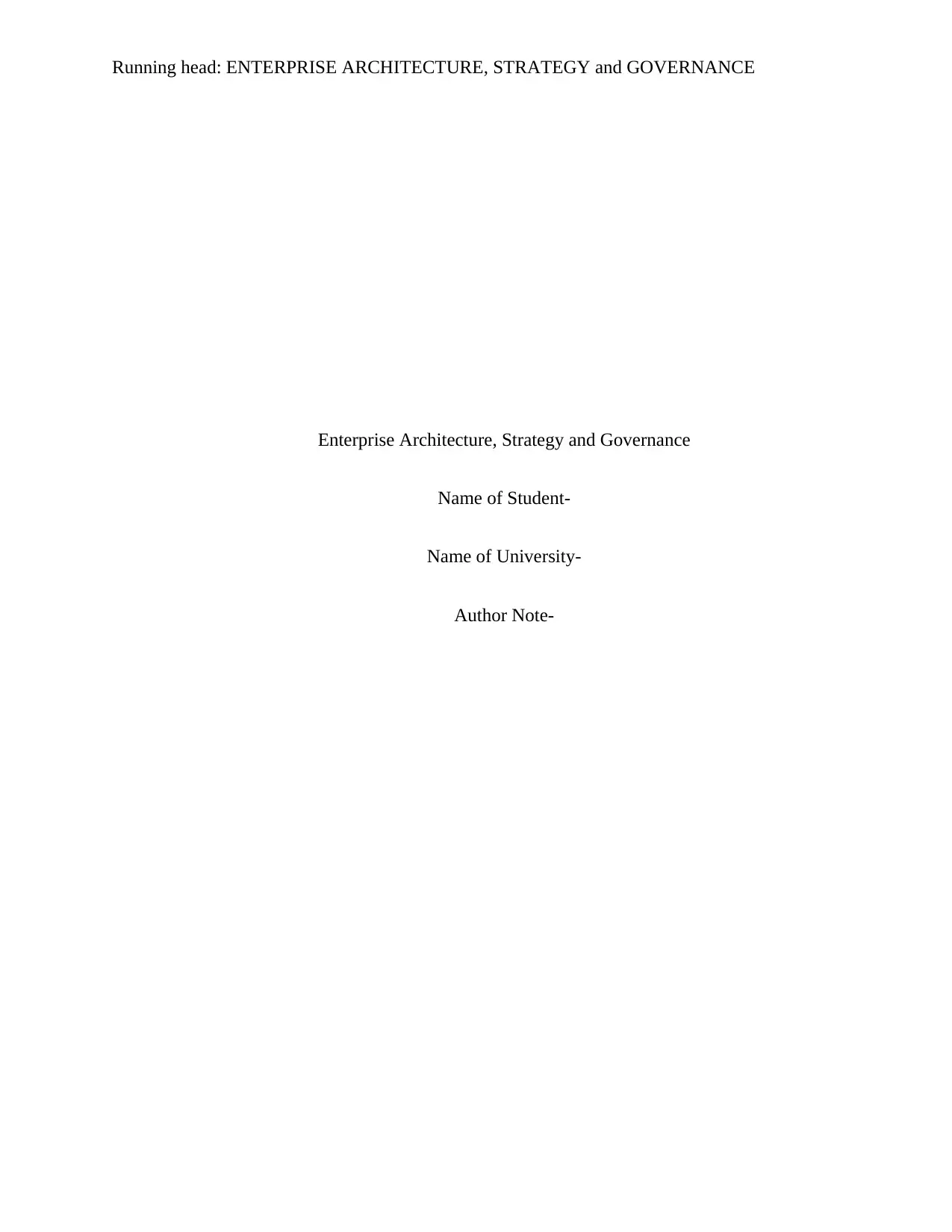
Running head: ENTERPRISE ARCHITECTURE, STRATEGY and GOVERNANCE
Enterprise Architecture, Strategy and Governance
Name of Student-
Name of University-
Author Note-
Enterprise Architecture, Strategy and Governance
Name of Student-
Name of University-
Author Note-
Paraphrase This Document
Need a fresh take? Get an instant paraphrase of this document with our AI Paraphraser
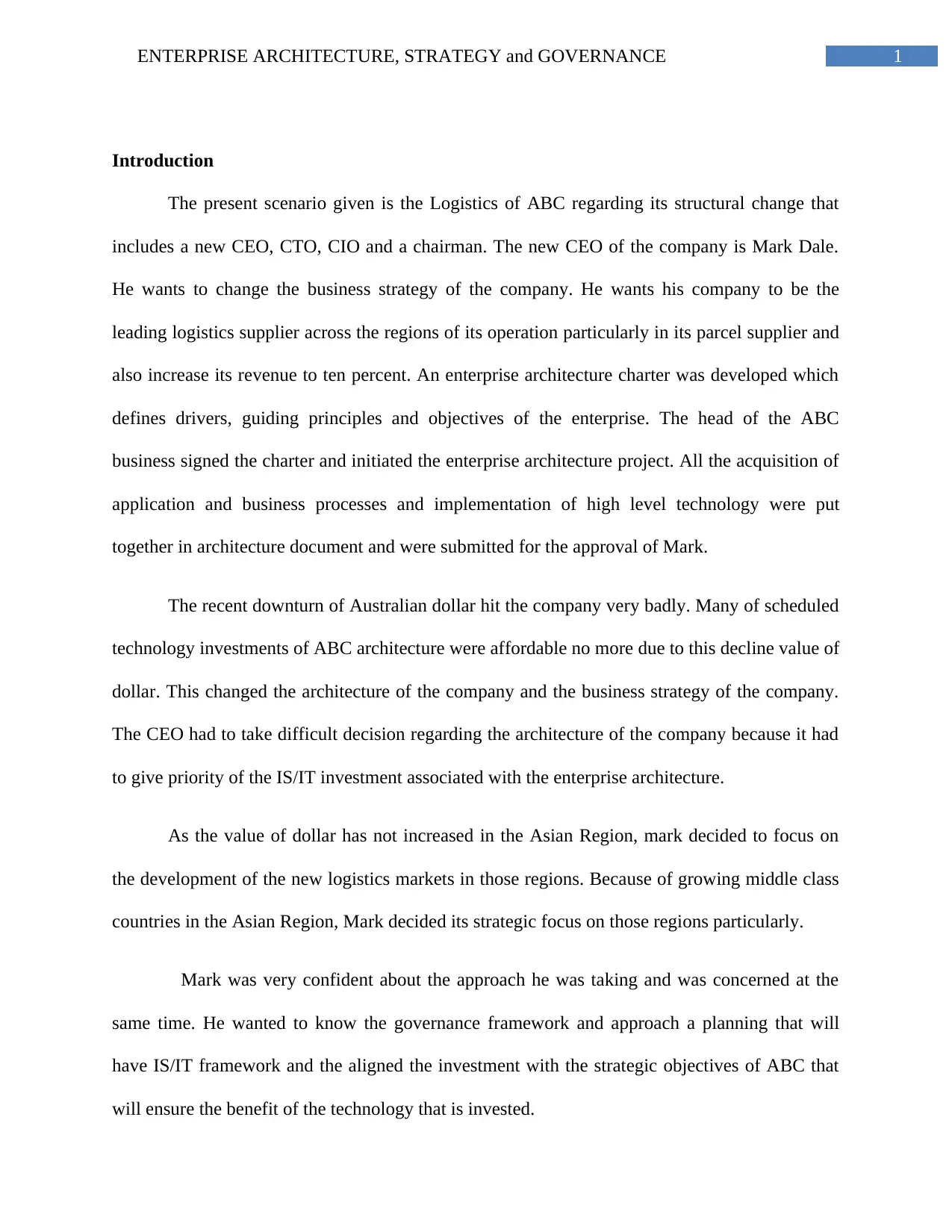
1ENTERPRISE ARCHITECTURE, STRATEGY and GOVERNANCE
Introduction
The present scenario given is the Logistics of ABC regarding its structural change that
includes a new CEO, CTO, CIO and a chairman. The new CEO of the company is Mark Dale.
He wants to change the business strategy of the company. He wants his company to be the
leading logistics supplier across the regions of its operation particularly in its parcel supplier and
also increase its revenue to ten percent. An enterprise architecture charter was developed which
defines drivers, guiding principles and objectives of the enterprise. The head of the ABC
business signed the charter and initiated the enterprise architecture project. All the acquisition of
application and business processes and implementation of high level technology were put
together in architecture document and were submitted for the approval of Mark.
The recent downturn of Australian dollar hit the company very badly. Many of scheduled
technology investments of ABC architecture were affordable no more due to this decline value of
dollar. This changed the architecture of the company and the business strategy of the company.
The CEO had to take difficult decision regarding the architecture of the company because it had
to give priority of the IS/IT investment associated with the enterprise architecture.
As the value of dollar has not increased in the Asian Region, mark decided to focus on
the development of the new logistics markets in those regions. Because of growing middle class
countries in the Asian Region, Mark decided its strategic focus on those regions particularly.
Mark was very confident about the approach he was taking and was concerned at the
same time. He wanted to know the governance framework and approach a planning that will
have IS/IT framework and the aligned the investment with the strategic objectives of ABC that
will ensure the benefit of the technology that is invested.
Introduction
The present scenario given is the Logistics of ABC regarding its structural change that
includes a new CEO, CTO, CIO and a chairman. The new CEO of the company is Mark Dale.
He wants to change the business strategy of the company. He wants his company to be the
leading logistics supplier across the regions of its operation particularly in its parcel supplier and
also increase its revenue to ten percent. An enterprise architecture charter was developed which
defines drivers, guiding principles and objectives of the enterprise. The head of the ABC
business signed the charter and initiated the enterprise architecture project. All the acquisition of
application and business processes and implementation of high level technology were put
together in architecture document and were submitted for the approval of Mark.
The recent downturn of Australian dollar hit the company very badly. Many of scheduled
technology investments of ABC architecture were affordable no more due to this decline value of
dollar. This changed the architecture of the company and the business strategy of the company.
The CEO had to take difficult decision regarding the architecture of the company because it had
to give priority of the IS/IT investment associated with the enterprise architecture.
As the value of dollar has not increased in the Asian Region, mark decided to focus on
the development of the new logistics markets in those regions. Because of growing middle class
countries in the Asian Region, Mark decided its strategic focus on those regions particularly.
Mark was very confident about the approach he was taking and was concerned at the
same time. He wanted to know the governance framework and approach a planning that will
have IS/IT framework and the aligned the investment with the strategic objectives of ABC that
will ensure the benefit of the technology that is invested.
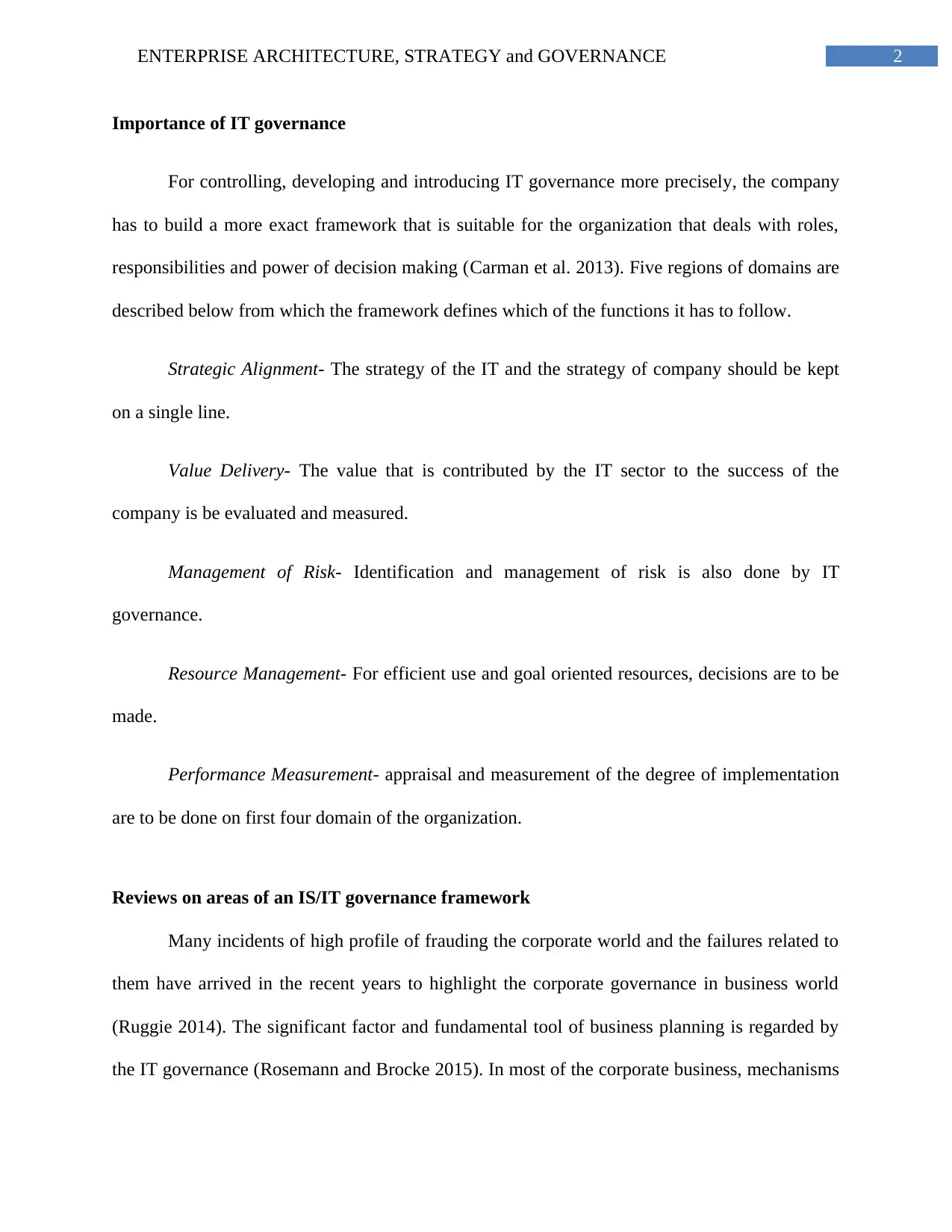
2ENTERPRISE ARCHITECTURE, STRATEGY and GOVERNANCE
Importance of IT governance
For controlling, developing and introducing IT governance more precisely, the company
has to build a more exact framework that is suitable for the organization that deals with roles,
responsibilities and power of decision making (Carman et al. 2013). Five regions of domains are
described below from which the framework defines which of the functions it has to follow.
Strategic Alignment- The strategy of the IT and the strategy of company should be kept
on a single line.
Value Delivery- The value that is contributed by the IT sector to the success of the
company is be evaluated and measured.
Management of Risk- Identification and management of risk is also done by IT
governance.
Resource Management- For efficient use and goal oriented resources, decisions are to be
made.
Performance Measurement- appraisal and measurement of the degree of implementation
are to be done on first four domain of the organization.
Reviews on areas of an IS/IT governance framework
Many incidents of high profile of frauding the corporate world and the failures related to
them have arrived in the recent years to highlight the corporate governance in business world
(Ruggie 2014). The significant factor and fundamental tool of business planning is regarded by
the IT governance (Rosemann and Brocke 2015). In most of the corporate business, mechanisms
Importance of IT governance
For controlling, developing and introducing IT governance more precisely, the company
has to build a more exact framework that is suitable for the organization that deals with roles,
responsibilities and power of decision making (Carman et al. 2013). Five regions of domains are
described below from which the framework defines which of the functions it has to follow.
Strategic Alignment- The strategy of the IT and the strategy of company should be kept
on a single line.
Value Delivery- The value that is contributed by the IT sector to the success of the
company is be evaluated and measured.
Management of Risk- Identification and management of risk is also done by IT
governance.
Resource Management- For efficient use and goal oriented resources, decisions are to be
made.
Performance Measurement- appraisal and measurement of the degree of implementation
are to be done on first four domain of the organization.
Reviews on areas of an IS/IT governance framework
Many incidents of high profile of frauding the corporate world and the failures related to
them have arrived in the recent years to highlight the corporate governance in business world
(Ruggie 2014). The significant factor and fundamental tool of business planning is regarded by
the IT governance (Rosemann and Brocke 2015). In most of the corporate business, mechanisms
⊘ This is a preview!⊘
Do you want full access?
Subscribe today to unlock all pages.

Trusted by 1+ million students worldwide
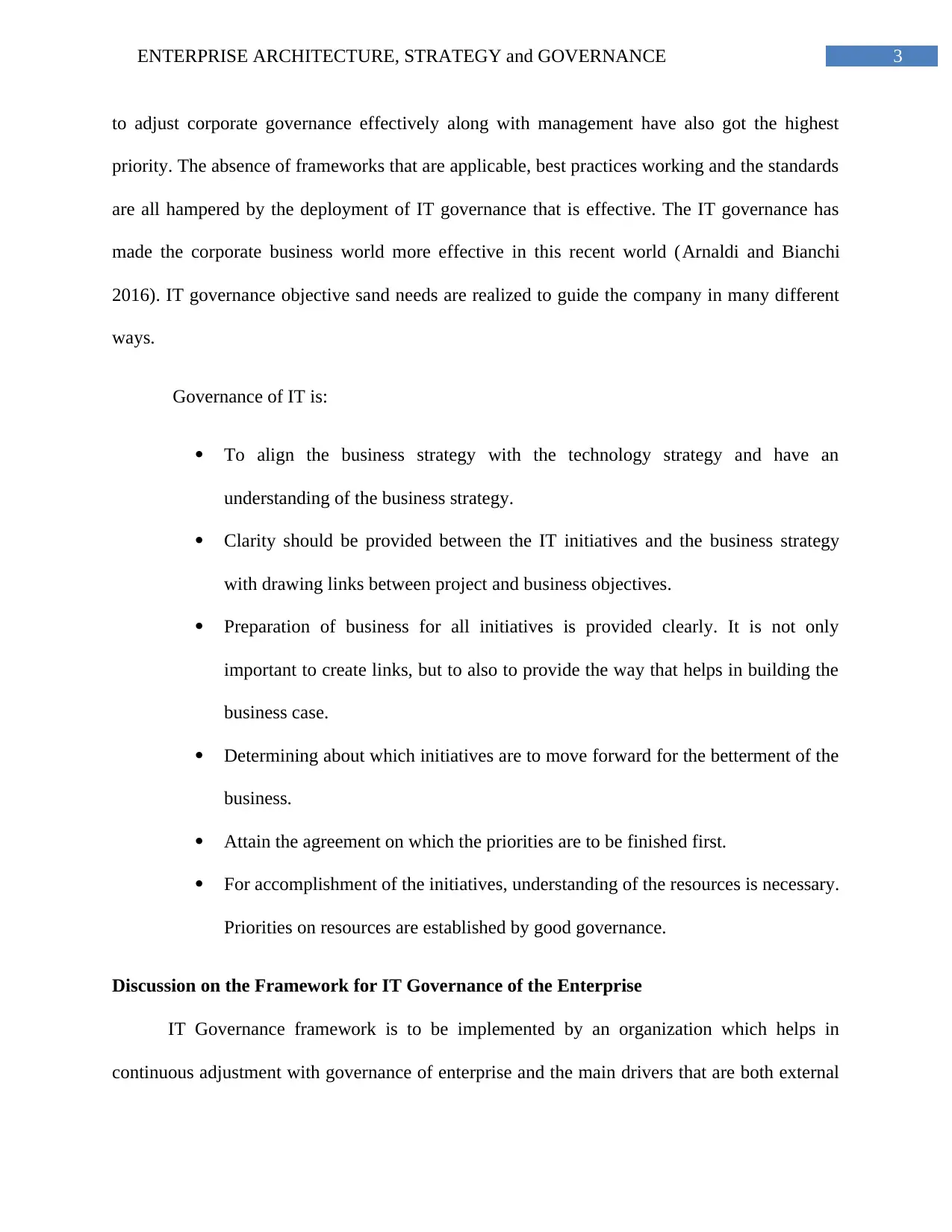
3ENTERPRISE ARCHITECTURE, STRATEGY and GOVERNANCE
to adjust corporate governance effectively along with management have also got the highest
priority. The absence of frameworks that are applicable, best practices working and the standards
are all hampered by the deployment of IT governance that is effective. The IT governance has
made the corporate business world more effective in this recent world (Arnaldi and Bianchi
2016). IT governance objective sand needs are realized to guide the company in many different
ways.
Governance of IT is:
To align the business strategy with the technology strategy and have an
understanding of the business strategy.
Clarity should be provided between the IT initiatives and the business strategy
with drawing links between project and business objectives.
Preparation of business for all initiatives is provided clearly. It is not only
important to create links, but to also to provide the way that helps in building the
business case.
Determining about which initiatives are to move forward for the betterment of the
business.
Attain the agreement on which the priorities are to be finished first.
For accomplishment of the initiatives, understanding of the resources is necessary.
Priorities on resources are established by good governance.
Discussion on the Framework for IT Governance of the Enterprise
IT Governance framework is to be implemented by an organization which helps in
continuous adjustment with governance of enterprise and the main drivers that are both external
to adjust corporate governance effectively along with management have also got the highest
priority. The absence of frameworks that are applicable, best practices working and the standards
are all hampered by the deployment of IT governance that is effective. The IT governance has
made the corporate business world more effective in this recent world (Arnaldi and Bianchi
2016). IT governance objective sand needs are realized to guide the company in many different
ways.
Governance of IT is:
To align the business strategy with the technology strategy and have an
understanding of the business strategy.
Clarity should be provided between the IT initiatives and the business strategy
with drawing links between project and business objectives.
Preparation of business for all initiatives is provided clearly. It is not only
important to create links, but to also to provide the way that helps in building the
business case.
Determining about which initiatives are to move forward for the betterment of the
business.
Attain the agreement on which the priorities are to be finished first.
For accomplishment of the initiatives, understanding of the resources is necessary.
Priorities on resources are established by good governance.
Discussion on the Framework for IT Governance of the Enterprise
IT Governance framework is to be implemented by an organization which helps in
continuous adjustment with governance of enterprise and the main drivers that are both external
Paraphrase This Document
Need a fresh take? Get an instant paraphrase of this document with our AI Paraphraser
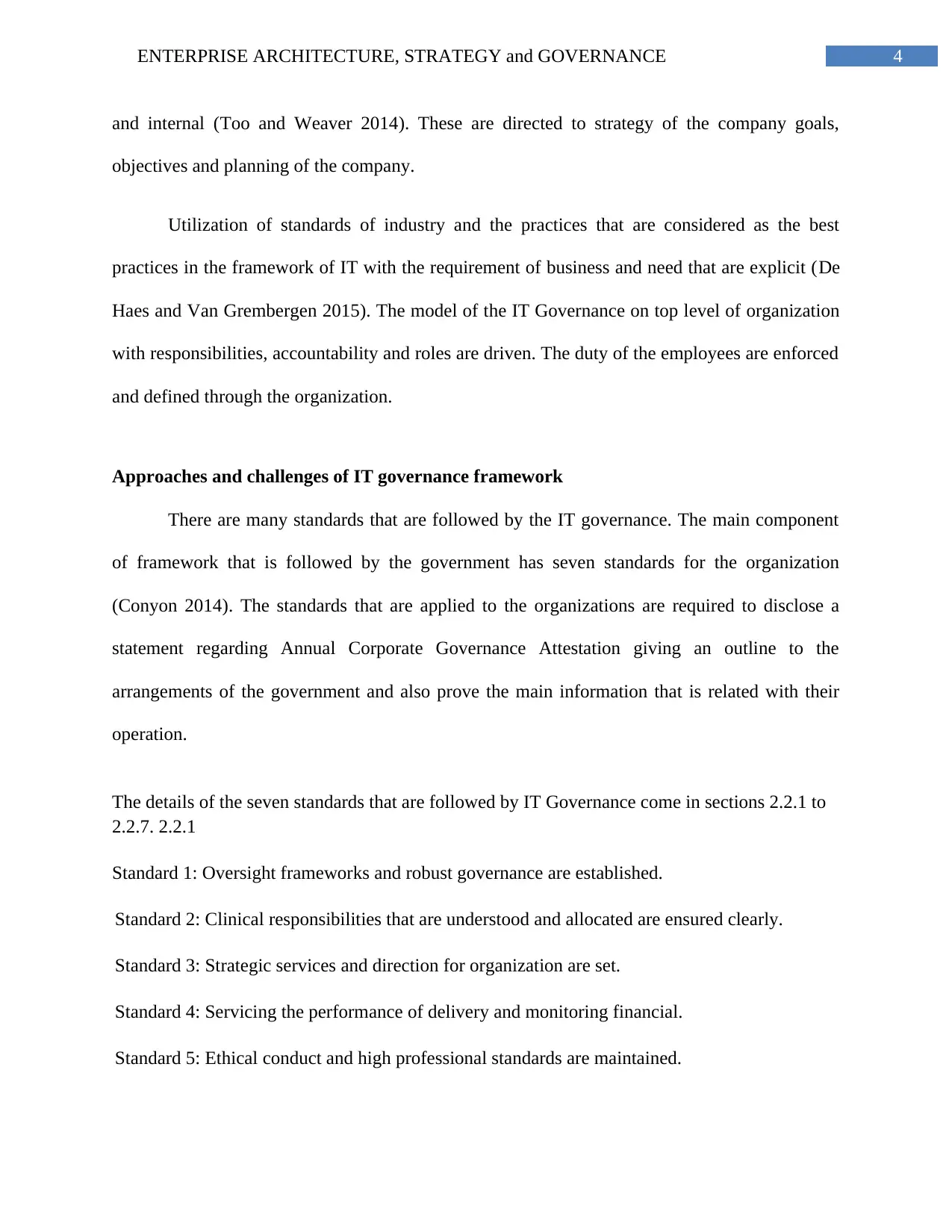
4ENTERPRISE ARCHITECTURE, STRATEGY and GOVERNANCE
and internal (Too and Weaver 2014). These are directed to strategy of the company goals,
objectives and planning of the company.
Utilization of standards of industry and the practices that are considered as the best
practices in the framework of IT with the requirement of business and need that are explicit (De
Haes and Van Grembergen 2015). The model of the IT Governance on top level of organization
with responsibilities, accountability and roles are driven. The duty of the employees are enforced
and defined through the organization.
Approaches and challenges of IT governance framework
There are many standards that are followed by the IT governance. The main component
of framework that is followed by the government has seven standards for the organization
(Conyon 2014). The standards that are applied to the organizations are required to disclose a
statement regarding Annual Corporate Governance Attestation giving an outline to the
arrangements of the government and also prove the main information that is related with their
operation.
The details of the seven standards that are followed by IT Governance come in sections 2.2.1 to
2.2.7. 2.2.1
Standard 1: Oversight frameworks and robust governance are established.
Standard 2: Clinical responsibilities that are understood and allocated are ensured clearly.
Standard 3: Strategic services and direction for organization are set.
Standard 4: Servicing the performance of delivery and monitoring financial.
Standard 5: Ethical conduct and high professional standards are maintained.
and internal (Too and Weaver 2014). These are directed to strategy of the company goals,
objectives and planning of the company.
Utilization of standards of industry and the practices that are considered as the best
practices in the framework of IT with the requirement of business and need that are explicit (De
Haes and Van Grembergen 2015). The model of the IT Governance on top level of organization
with responsibilities, accountability and roles are driven. The duty of the employees are enforced
and defined through the organization.
Approaches and challenges of IT governance framework
There are many standards that are followed by the IT governance. The main component
of framework that is followed by the government has seven standards for the organization
(Conyon 2014). The standards that are applied to the organizations are required to disclose a
statement regarding Annual Corporate Governance Attestation giving an outline to the
arrangements of the government and also prove the main information that is related with their
operation.
The details of the seven standards that are followed by IT Governance come in sections 2.2.1 to
2.2.7. 2.2.1
Standard 1: Oversight frameworks and robust governance are established.
Standard 2: Clinical responsibilities that are understood and allocated are ensured clearly.
Standard 3: Strategic services and direction for organization are set.
Standard 4: Servicing the performance of delivery and monitoring financial.
Standard 5: Ethical conduct and high professional standards are maintained.
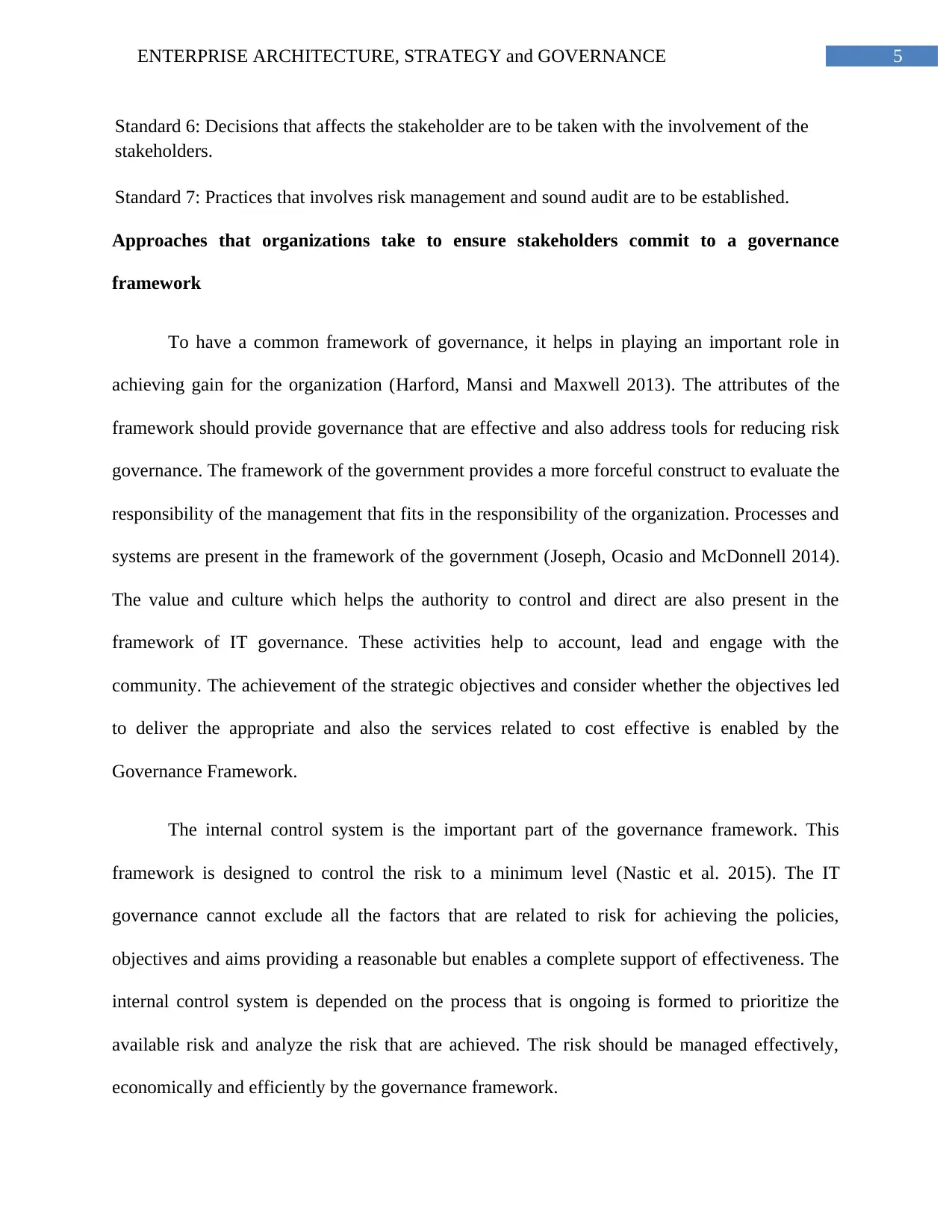
5ENTERPRISE ARCHITECTURE, STRATEGY and GOVERNANCE
Standard 6: Decisions that affects the stakeholder are to be taken with the involvement of the
stakeholders.
Standard 7: Practices that involves risk management and sound audit are to be established.
Approaches that organizations take to ensure stakeholders commit to a governance
framework
To have a common framework of governance, it helps in playing an important role in
achieving gain for the organization (Harford, Mansi and Maxwell 2013). The attributes of the
framework should provide governance that are effective and also address tools for reducing risk
governance. The framework of the government provides a more forceful construct to evaluate the
responsibility of the management that fits in the responsibility of the organization. Processes and
systems are present in the framework of the government (Joseph, Ocasio and McDonnell 2014).
The value and culture which helps the authority to control and direct are also present in the
framework of IT governance. These activities help to account, lead and engage with the
community. The achievement of the strategic objectives and consider whether the objectives led
to deliver the appropriate and also the services related to cost effective is enabled by the
Governance Framework.
The internal control system is the important part of the governance framework. This
framework is designed to control the risk to a minimum level (Nastic et al. 2015). The IT
governance cannot exclude all the factors that are related to risk for achieving the policies,
objectives and aims providing a reasonable but enables a complete support of effectiveness. The
internal control system is depended on the process that is ongoing is formed to prioritize the
available risk and analyze the risk that are achieved. The risk should be managed effectively,
economically and efficiently by the governance framework.
Standard 6: Decisions that affects the stakeholder are to be taken with the involvement of the
stakeholders.
Standard 7: Practices that involves risk management and sound audit are to be established.
Approaches that organizations take to ensure stakeholders commit to a governance
framework
To have a common framework of governance, it helps in playing an important role in
achieving gain for the organization (Harford, Mansi and Maxwell 2013). The attributes of the
framework should provide governance that are effective and also address tools for reducing risk
governance. The framework of the government provides a more forceful construct to evaluate the
responsibility of the management that fits in the responsibility of the organization. Processes and
systems are present in the framework of the government (Joseph, Ocasio and McDonnell 2014).
The value and culture which helps the authority to control and direct are also present in the
framework of IT governance. These activities help to account, lead and engage with the
community. The achievement of the strategic objectives and consider whether the objectives led
to deliver the appropriate and also the services related to cost effective is enabled by the
Governance Framework.
The internal control system is the important part of the governance framework. This
framework is designed to control the risk to a minimum level (Nastic et al. 2015). The IT
governance cannot exclude all the factors that are related to risk for achieving the policies,
objectives and aims providing a reasonable but enables a complete support of effectiveness. The
internal control system is depended on the process that is ongoing is formed to prioritize the
available risk and analyze the risk that are achieved. The risk should be managed effectively,
economically and efficiently by the governance framework.
⊘ This is a preview!⊘
Do you want full access?
Subscribe today to unlock all pages.

Trusted by 1+ million students worldwide
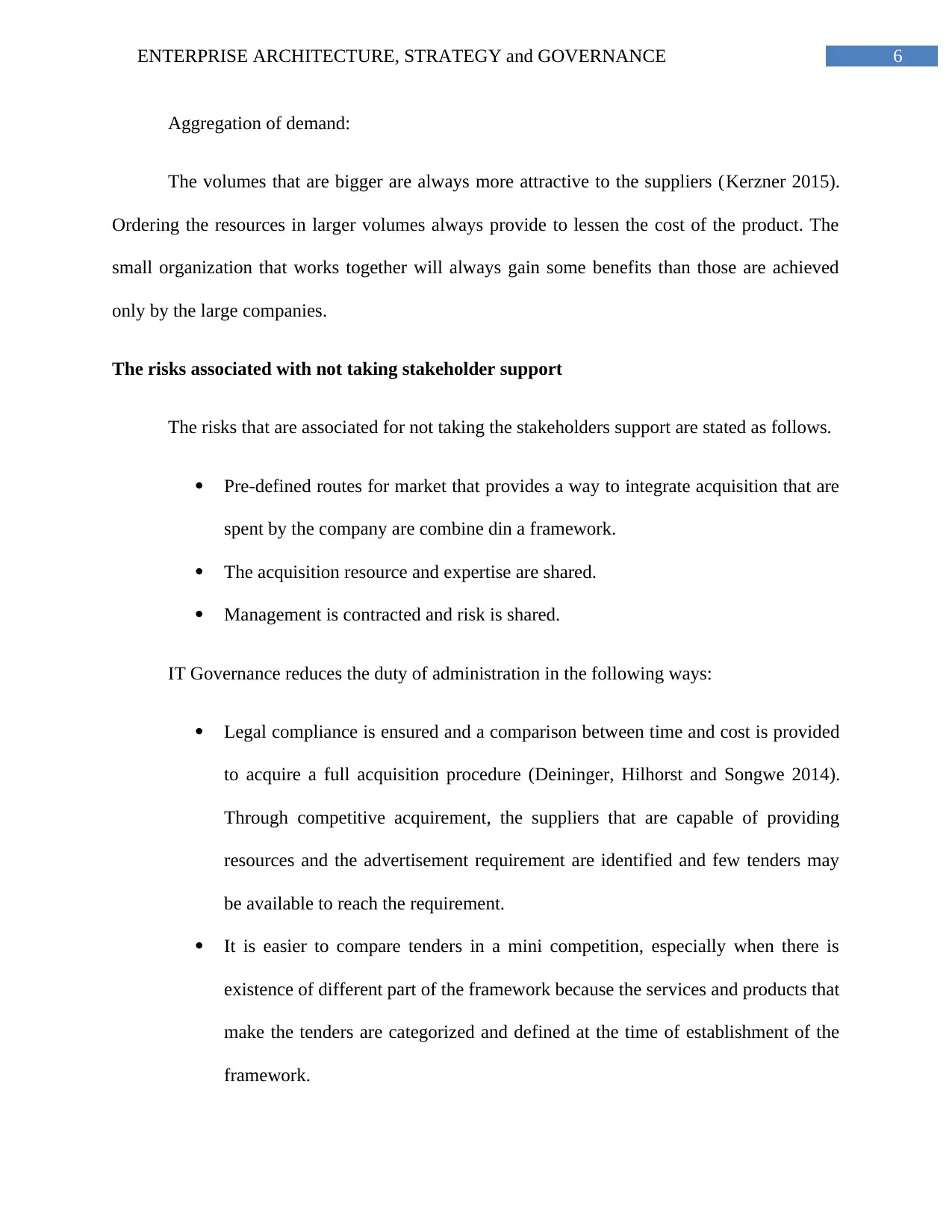
6ENTERPRISE ARCHITECTURE, STRATEGY and GOVERNANCE
Aggregation of demand:
The volumes that are bigger are always more attractive to the suppliers (Kerzner 2015).
Ordering the resources in larger volumes always provide to lessen the cost of the product. The
small organization that works together will always gain some benefits than those are achieved
only by the large companies.
The risks associated with not taking stakeholder support
The risks that are associated for not taking the stakeholders support are stated as follows.
Pre-defined routes for market that provides a way to integrate acquisition that are
spent by the company are combine din a framework.
The acquisition resource and expertise are shared.
Management is contracted and risk is shared.
IT Governance reduces the duty of administration in the following ways:
Legal compliance is ensured and a comparison between time and cost is provided
to acquire a full acquisition procedure (Deininger, Hilhorst and Songwe 2014).
Through competitive acquirement, the suppliers that are capable of providing
resources and the advertisement requirement are identified and few tenders may
be available to reach the requirement.
It is easier to compare tenders in a mini competition, especially when there is
existence of different part of the framework because the services and products that
make the tenders are categorized and defined at the time of establishment of the
framework.
Aggregation of demand:
The volumes that are bigger are always more attractive to the suppliers (Kerzner 2015).
Ordering the resources in larger volumes always provide to lessen the cost of the product. The
small organization that works together will always gain some benefits than those are achieved
only by the large companies.
The risks associated with not taking stakeholder support
The risks that are associated for not taking the stakeholders support are stated as follows.
Pre-defined routes for market that provides a way to integrate acquisition that are
spent by the company are combine din a framework.
The acquisition resource and expertise are shared.
Management is contracted and risk is shared.
IT Governance reduces the duty of administration in the following ways:
Legal compliance is ensured and a comparison between time and cost is provided
to acquire a full acquisition procedure (Deininger, Hilhorst and Songwe 2014).
Through competitive acquirement, the suppliers that are capable of providing
resources and the advertisement requirement are identified and few tenders may
be available to reach the requirement.
It is easier to compare tenders in a mini competition, especially when there is
existence of different part of the framework because the services and products that
make the tenders are categorized and defined at the time of establishment of the
framework.
Paraphrase This Document
Need a fresh take? Get an instant paraphrase of this document with our AI Paraphraser
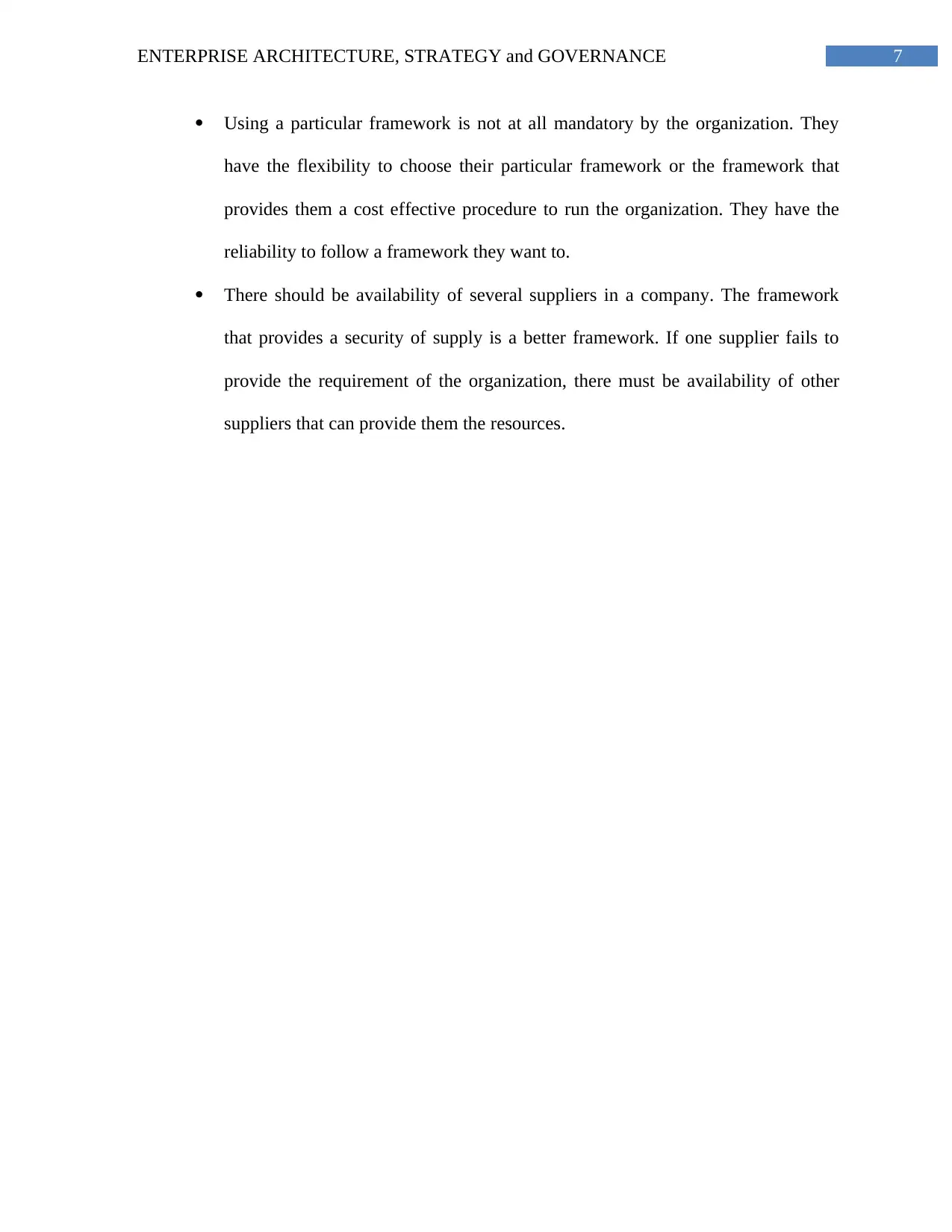
7ENTERPRISE ARCHITECTURE, STRATEGY and GOVERNANCE
Using a particular framework is not at all mandatory by the organization. They
have the flexibility to choose their particular framework or the framework that
provides them a cost effective procedure to run the organization. They have the
reliability to follow a framework they want to.
There should be availability of several suppliers in a company. The framework
that provides a security of supply is a better framework. If one supplier fails to
provide the requirement of the organization, there must be availability of other
suppliers that can provide them the resources.
Using a particular framework is not at all mandatory by the organization. They
have the flexibility to choose their particular framework or the framework that
provides them a cost effective procedure to run the organization. They have the
reliability to follow a framework they want to.
There should be availability of several suppliers in a company. The framework
that provides a security of supply is a better framework. If one supplier fails to
provide the requirement of the organization, there must be availability of other
suppliers that can provide them the resources.
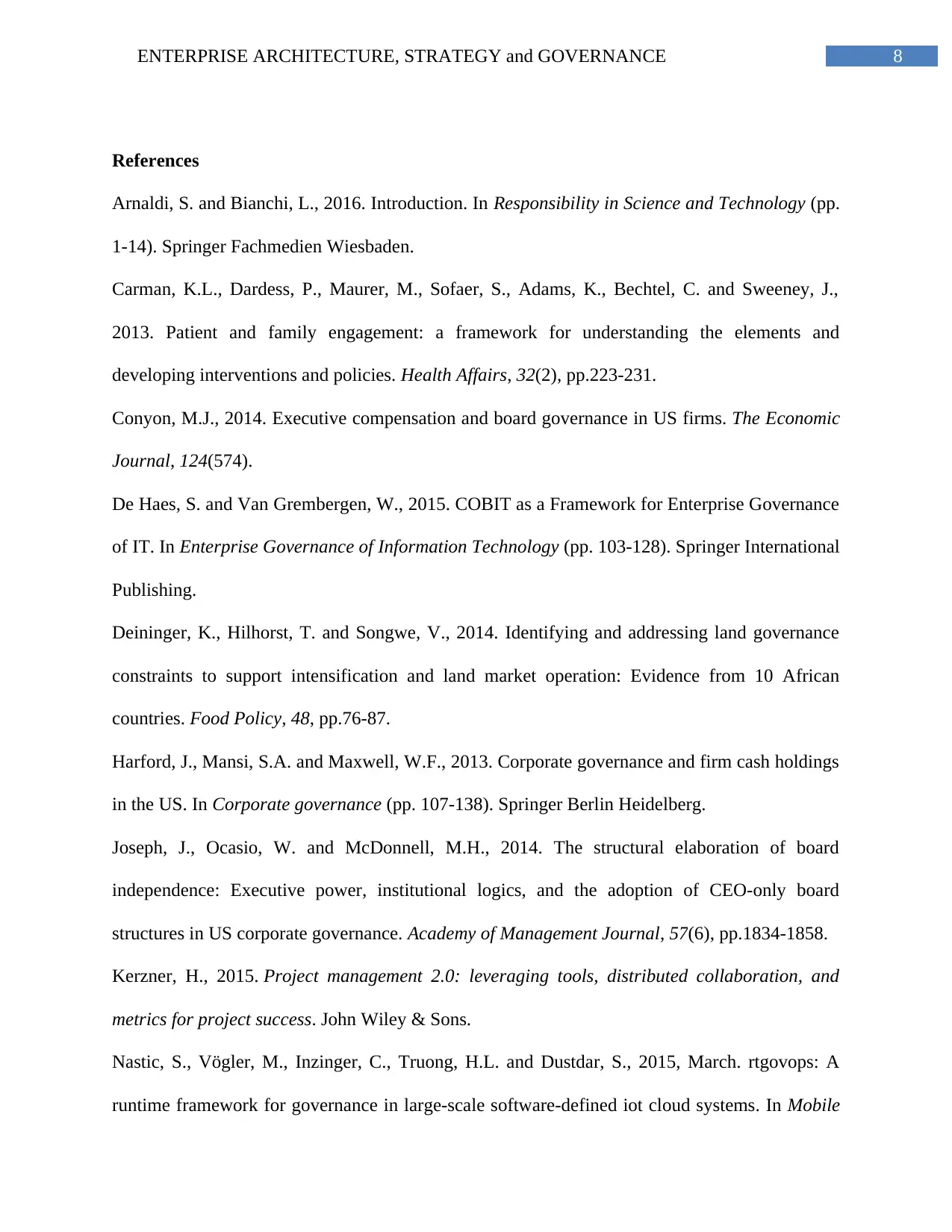
8ENTERPRISE ARCHITECTURE, STRATEGY and GOVERNANCE
References
Arnaldi, S. and Bianchi, L., 2016. Introduction. In Responsibility in Science and Technology (pp.
1-14). Springer Fachmedien Wiesbaden.
Carman, K.L., Dardess, P., Maurer, M., Sofaer, S., Adams, K., Bechtel, C. and Sweeney, J.,
2013. Patient and family engagement: a framework for understanding the elements and
developing interventions and policies. Health Affairs, 32(2), pp.223-231.
Conyon, M.J., 2014. Executive compensation and board governance in US firms. The Economic
Journal, 124(574).
De Haes, S. and Van Grembergen, W., 2015. COBIT as a Framework for Enterprise Governance
of IT. In Enterprise Governance of Information Technology (pp. 103-128). Springer International
Publishing.
Deininger, K., Hilhorst, T. and Songwe, V., 2014. Identifying and addressing land governance
constraints to support intensification and land market operation: Evidence from 10 African
countries. Food Policy, 48, pp.76-87.
Harford, J., Mansi, S.A. and Maxwell, W.F., 2013. Corporate governance and firm cash holdings
in the US. In Corporate governance (pp. 107-138). Springer Berlin Heidelberg.
Joseph, J., Ocasio, W. and McDonnell, M.H., 2014. The structural elaboration of board
independence: Executive power, institutional logics, and the adoption of CEO-only board
structures in US corporate governance. Academy of Management Journal, 57(6), pp.1834-1858.
Kerzner, H., 2015. Project management 2.0: leveraging tools, distributed collaboration, and
metrics for project success. John Wiley & Sons.
Nastic, S., Vögler, M., Inzinger, C., Truong, H.L. and Dustdar, S., 2015, March. rtgovops: A
runtime framework for governance in large-scale software-defined iot cloud systems. In Mobile
References
Arnaldi, S. and Bianchi, L., 2016. Introduction. In Responsibility in Science and Technology (pp.
1-14). Springer Fachmedien Wiesbaden.
Carman, K.L., Dardess, P., Maurer, M., Sofaer, S., Adams, K., Bechtel, C. and Sweeney, J.,
2013. Patient and family engagement: a framework for understanding the elements and
developing interventions and policies. Health Affairs, 32(2), pp.223-231.
Conyon, M.J., 2014. Executive compensation and board governance in US firms. The Economic
Journal, 124(574).
De Haes, S. and Van Grembergen, W., 2015. COBIT as a Framework for Enterprise Governance
of IT. In Enterprise Governance of Information Technology (pp. 103-128). Springer International
Publishing.
Deininger, K., Hilhorst, T. and Songwe, V., 2014. Identifying and addressing land governance
constraints to support intensification and land market operation: Evidence from 10 African
countries. Food Policy, 48, pp.76-87.
Harford, J., Mansi, S.A. and Maxwell, W.F., 2013. Corporate governance and firm cash holdings
in the US. In Corporate governance (pp. 107-138). Springer Berlin Heidelberg.
Joseph, J., Ocasio, W. and McDonnell, M.H., 2014. The structural elaboration of board
independence: Executive power, institutional logics, and the adoption of CEO-only board
structures in US corporate governance. Academy of Management Journal, 57(6), pp.1834-1858.
Kerzner, H., 2015. Project management 2.0: leveraging tools, distributed collaboration, and
metrics for project success. John Wiley & Sons.
Nastic, S., Vögler, M., Inzinger, C., Truong, H.L. and Dustdar, S., 2015, March. rtgovops: A
runtime framework for governance in large-scale software-defined iot cloud systems. In Mobile
⊘ This is a preview!⊘
Do you want full access?
Subscribe today to unlock all pages.

Trusted by 1+ million students worldwide
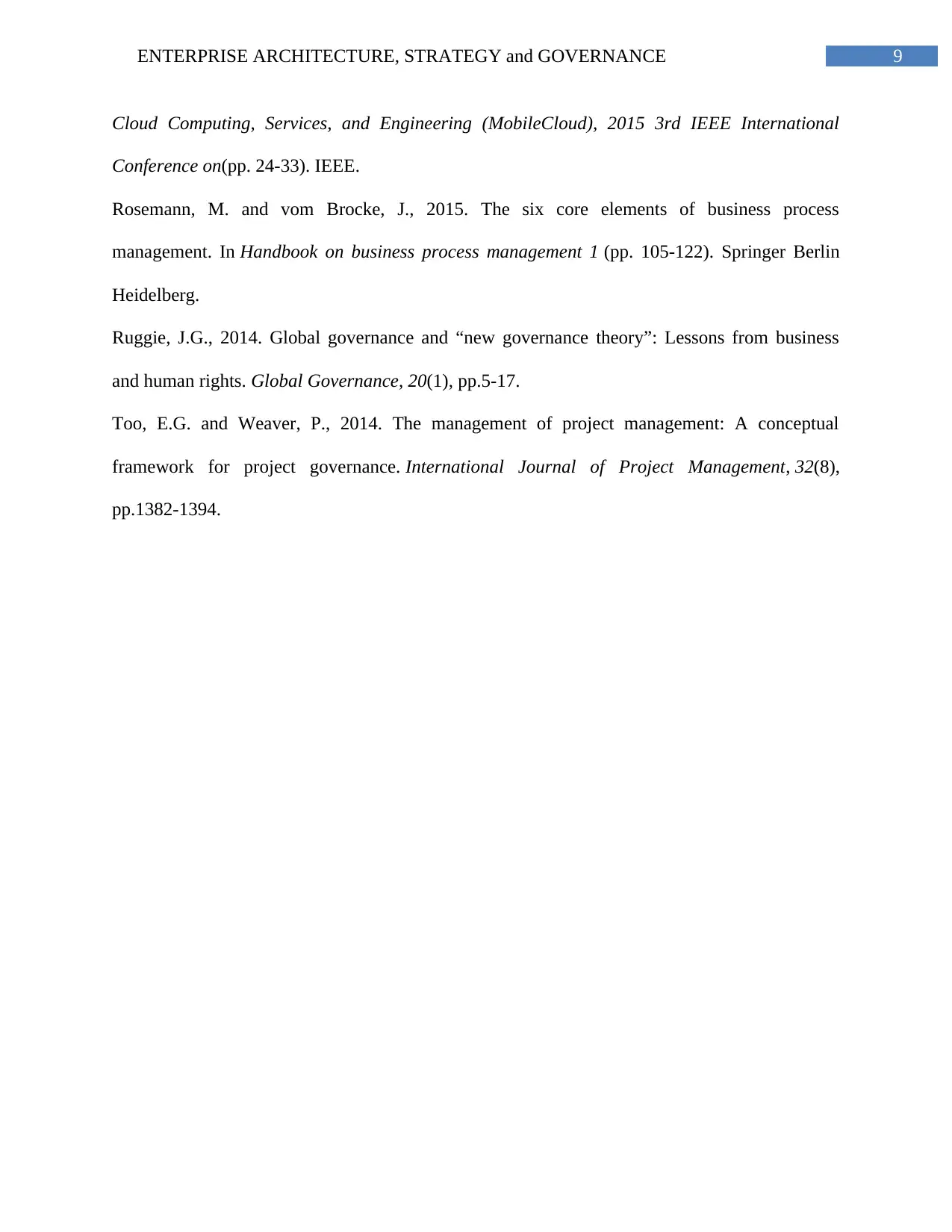
9ENTERPRISE ARCHITECTURE, STRATEGY and GOVERNANCE
Cloud Computing, Services, and Engineering (MobileCloud), 2015 3rd IEEE International
Conference on(pp. 24-33). IEEE.
Rosemann, M. and vom Brocke, J., 2015. The six core elements of business process
management. In Handbook on business process management 1 (pp. 105-122). Springer Berlin
Heidelberg.
Ruggie, J.G., 2014. Global governance and “new governance theory”: Lessons from business
and human rights. Global Governance, 20(1), pp.5-17.
Too, E.G. and Weaver, P., 2014. The management of project management: A conceptual
framework for project governance. International Journal of Project Management, 32(8),
pp.1382-1394.
Cloud Computing, Services, and Engineering (MobileCloud), 2015 3rd IEEE International
Conference on(pp. 24-33). IEEE.
Rosemann, M. and vom Brocke, J., 2015. The six core elements of business process
management. In Handbook on business process management 1 (pp. 105-122). Springer Berlin
Heidelberg.
Ruggie, J.G., 2014. Global governance and “new governance theory”: Lessons from business
and human rights. Global Governance, 20(1), pp.5-17.
Too, E.G. and Weaver, P., 2014. The management of project management: A conceptual
framework for project governance. International Journal of Project Management, 32(8),
pp.1382-1394.
1 out of 10
Related Documents
Your All-in-One AI-Powered Toolkit for Academic Success.
+13062052269
info@desklib.com
Available 24*7 on WhatsApp / Email
![[object Object]](/_next/static/media/star-bottom.7253800d.svg)
Unlock your academic potential
Copyright © 2020–2025 A2Z Services. All Rights Reserved. Developed and managed by ZUCOL.



